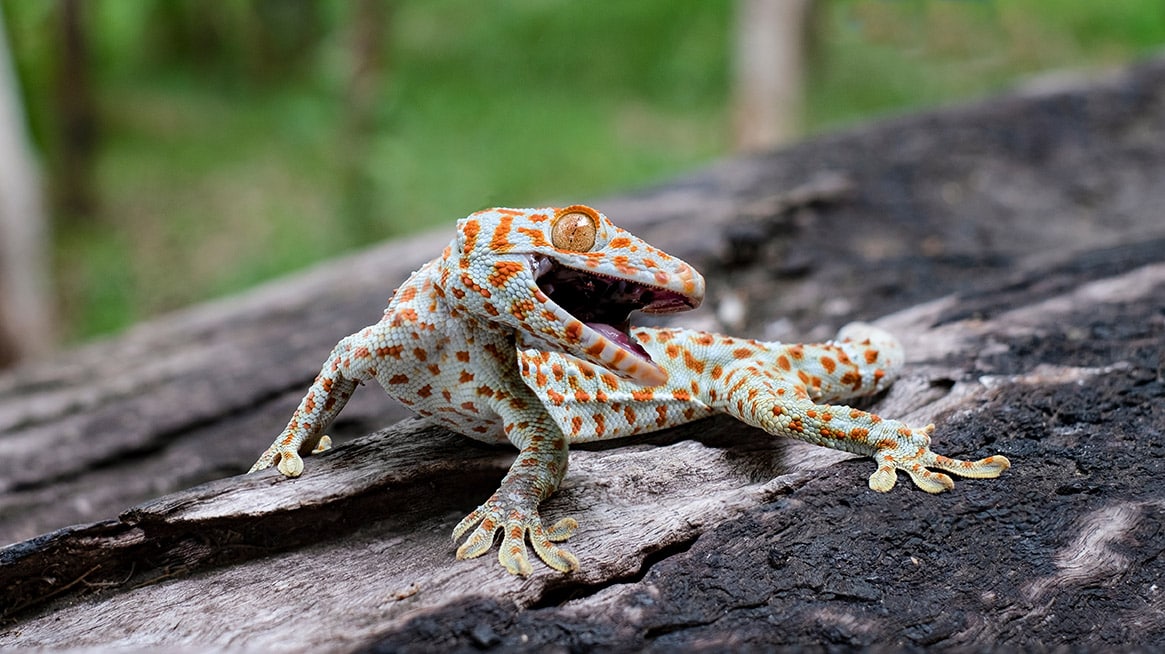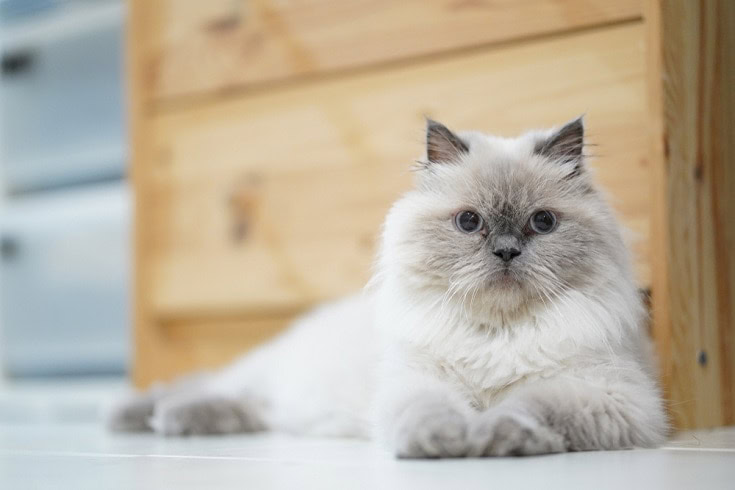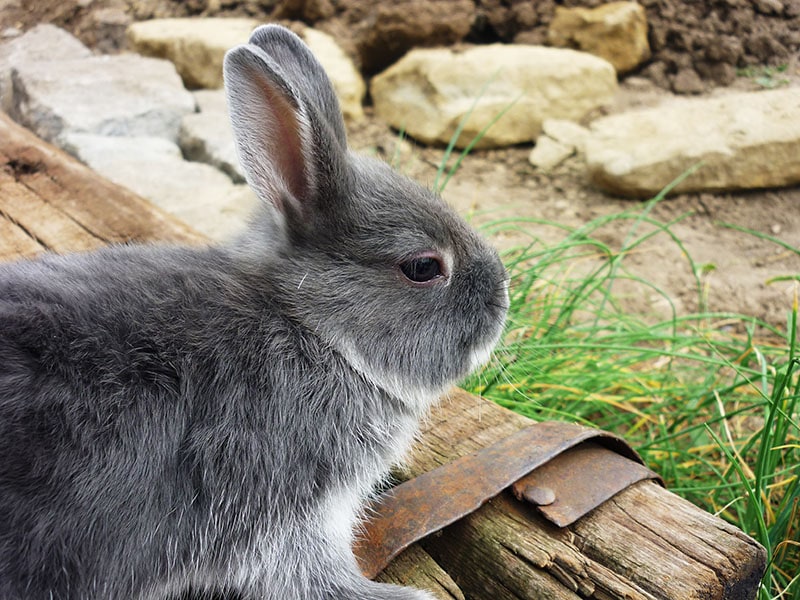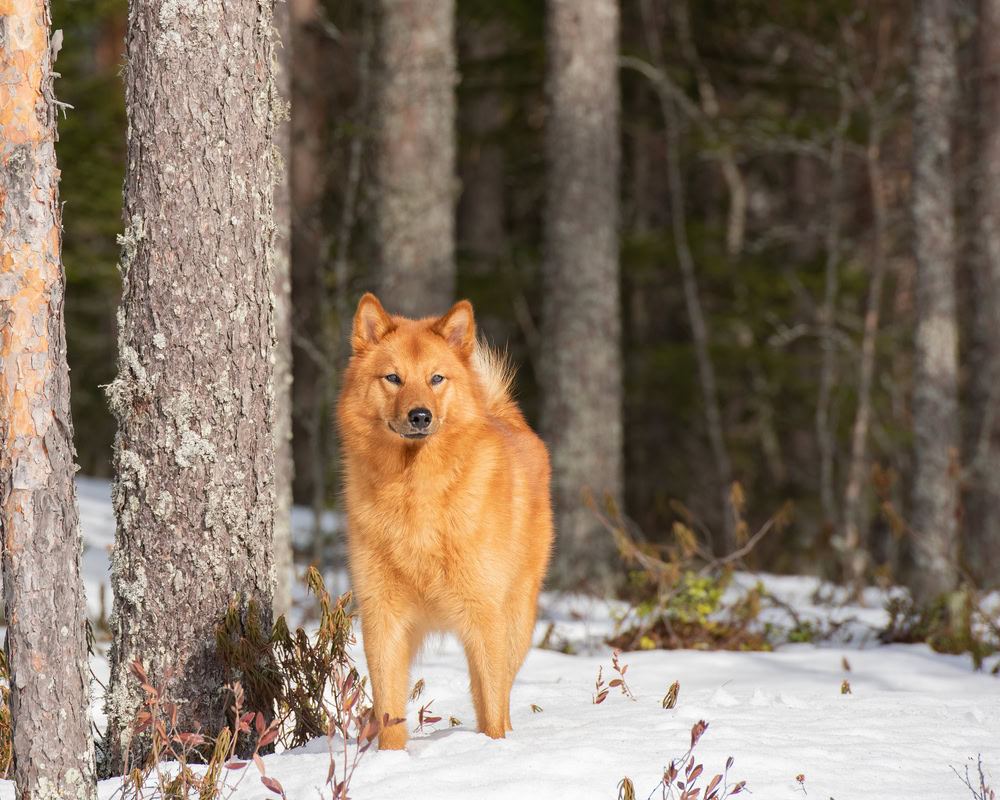Click to Skip Ahead
The Tokay Gecko is the third-largest of all gecko species, reaching a length of up to 15 inches. They are thick and strong but still incredibly quick. They’re also vibrantly colored, sporting shades of vibrant blues, grays, greens, reds, oranges, and blacks. They’re also covered in patterns of colored dots that contrast their base colors.
As pets, these geckos can live for 10–15 years, so getting one is a serious commitment. However, they’re not a great fit for someone who’s new to owning reptiles, as these aren’t the friendliest of lizards. They’re known for being aggressive, territorial, and difficult to handle. If you want a tame and docile Tokay Gecko, you’ll need a great deal of patience and previous experience with similar reptiles.

Quick Facts About Tokay Geckos
| Species Name: | Gekko gecko |
| Family: | Gekkonidae |
| Care Level: | Moderate to high |
| Temperature: | 75–85 degrees Fahrenheit |
| Temperament: | Aggressive |
| Color Form: | Various |
| Lifespan: | 10–15 years |
| Size: | 12–15 inches |
| Diet: | Insects |
| Minimum Tank Size: | 20 gallons |
| Tank Set-Up: | Cluttered with plenty of hiding spots |
| Compatibility: | Only for experienced reptile owners |
Tokay Gecko Overview
The Tokay Gecko looks distinctly different from most other common gecko breeds. They are much thicker and larger, with a cylindrical body and a large head that has powerful jaws for biting. These lizards rely on their coloration for camouflage and can even adjust their shade to be darker or lighter to better hide in any environment, though they can’t change colors like a chameleon.
Further improving their camouflage are skin folds on their bodies that open up completely. This breaks up their shadow, making it nearly impossible to see. When in danger, a Tokay Gecko can cast their tail off in several sections. The shed tail will continue to wriggle for long enough to distract any predators while the gecko escapes. It takes just 3 weeks for a new tail to grow back, though the new one isn’t usually as long.
These are aggressive and territorial lizards, making them difficult to tame. You should expect to put a lot of effort and time into gaining your Tokay Gecko’s trust before they will allow you to handle them. Be careful, though, as they are known to deliver a pretty nasty bite. Even with lots of care and time spent, this animal will never be truly handleable, like some other gecko species often are.
Tokay Geckos are also known for their loud vocalizations. These are used mainly as warnings to other lizards that are in or near their territory, along with a mating call that males use to attract females. But the vocalizations are loud enough to warrant keeping your lizards far from your bedroom, lest you wake up each night to a cacophony of lizard calls!
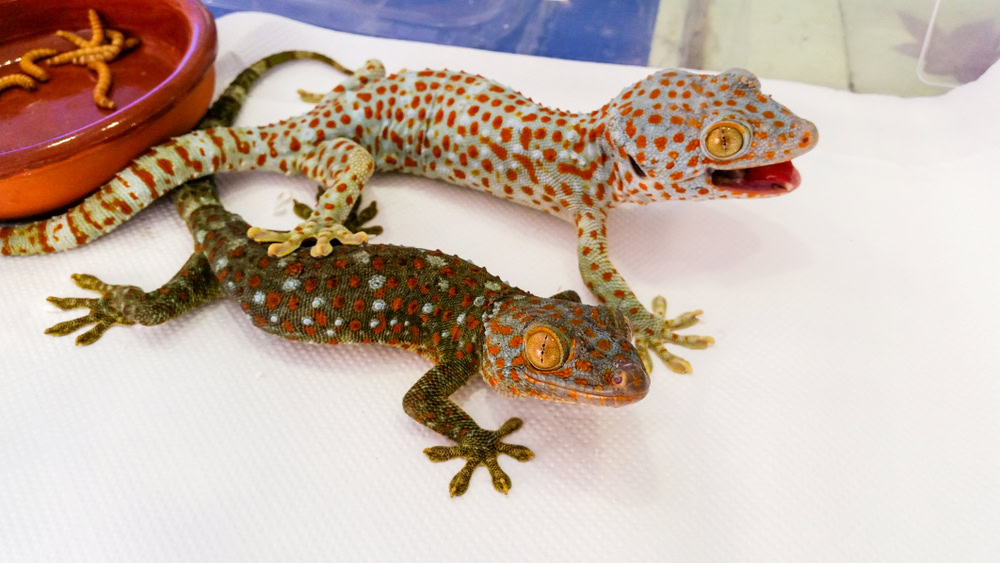
How Much Do Tokay Geckos Cost?
Considering their size and beauty, Tokay Geckos are affordable. On average, they cost just $40, though you should expect to pay substantially more if you’re looking for a specialized morph with unique coloration. That said, even Tokays with standard coloration are vibrant, colorful, and quite a sight to behold.
Remember, if you purchase your lizard from an online vendor, you’ll have to pay for shipping. This is usually a flat rate fee between $40 and $60, but that will cover multiple reptiles in one shipment. Luckily, Tokay Geckos are common, so you should be able to find one in a local store where you won’t have to pay shipping costs. Even some big chain pet stores sell these lizards, so look around.
Typical Behavior & Temperament
If you’re looking for a friendly lizard that you can hold or allow it to climb on you, you’ll want to bypass the Tokay Gecko. They may be beautiful but they are not friendly. They have a reputation for being territorial, aggressive lizards that are not that handleable. Holding one at all requires lots of patience, time, and careful training, and you’ll still probably incur a few bites along the way.
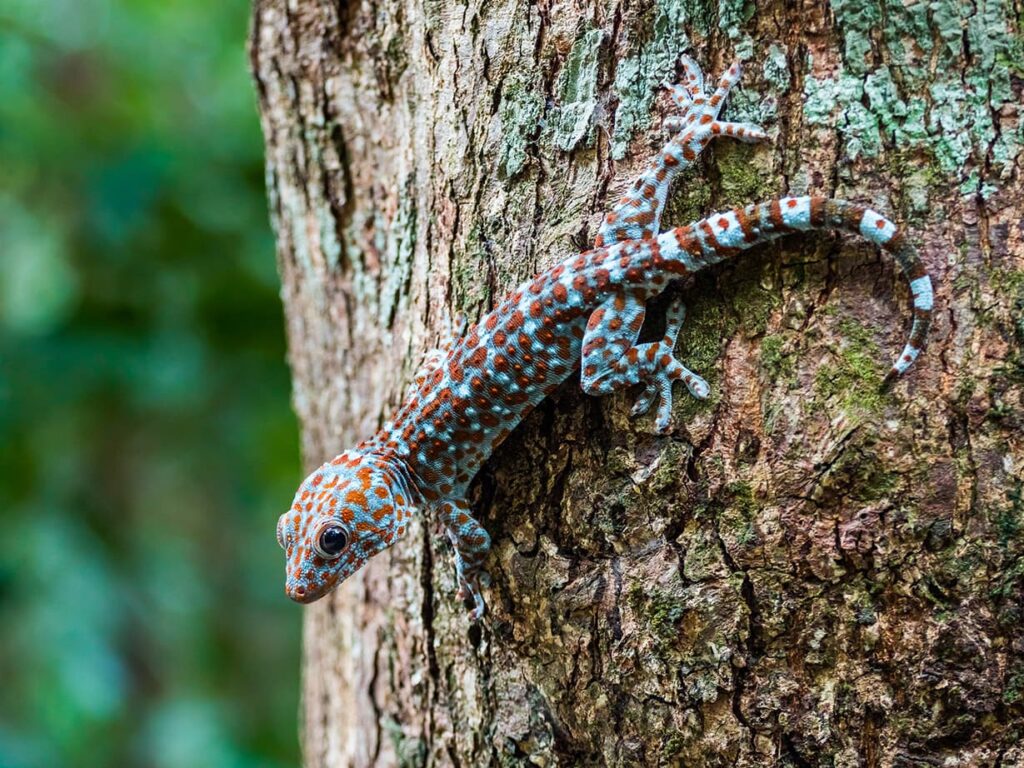
Appearance & Varieties
In the wild, Tokay Geckos come in two main varieties, red spotted and black spotted. The latter has spots that range from gray to black, while the spots on the former can vary from yellow and orange to red. The base colors can be just as diverse, coming in various shades of blue, green, gray, silver, and black.
While there are only two main varieties that occur naturally, multiple color morphs have been created in captivity through selective breeding. Some morphs are multi-colored, displaying base colors that change from head to tail. Others might display a head that is a separate color from the body or colors that don’t appear naturally.
- Blue Granite
- Calico
- Blue Granite Calico
- Yellow, Green, and Blue Granite
- Orange and Blue Granite
- Powder Blue
- Patternless Axanthic
- Blue-Headed Green
- Hypomelanistic

How to Take Care of a Tokay Gecko
Habitat, Tank Conditions & Setup
If you provide everything your Tokay Gecko needs, they can live for more than a decade. But these animals have specific living requirements that you’ll have to meet.
Enclosure
Tokay Geckos are far larger than most other gecko species. As such, they require more space. A single Tokay Gecko should be housed in an aquarium that’s 20 gallons or larger. They love to climb, though, so if you can get a larger enclosure that’s tall enough for climbing structures, your pet will certainly benefit. The tank needs to have a secure lid, since these lizards are so strong. You also want to ensure that the enclosure that you pick provides ample airflow. Glass aquariums are preferred because they enable heat to dissipate quickly.
Temperature
The ambient air temperature in your gecko’s enclosure should remain between 75 and 85 degrees Fahrenheit during the day, though it can cool off by a few degrees at night. In addition to keeping the enclosure warm, you’ll also need to provide a basking area under a heat lamp. Monitor this basking area with a thermometer so you can be certain that it remains between 90 and 105 degrees Fahrenheit.
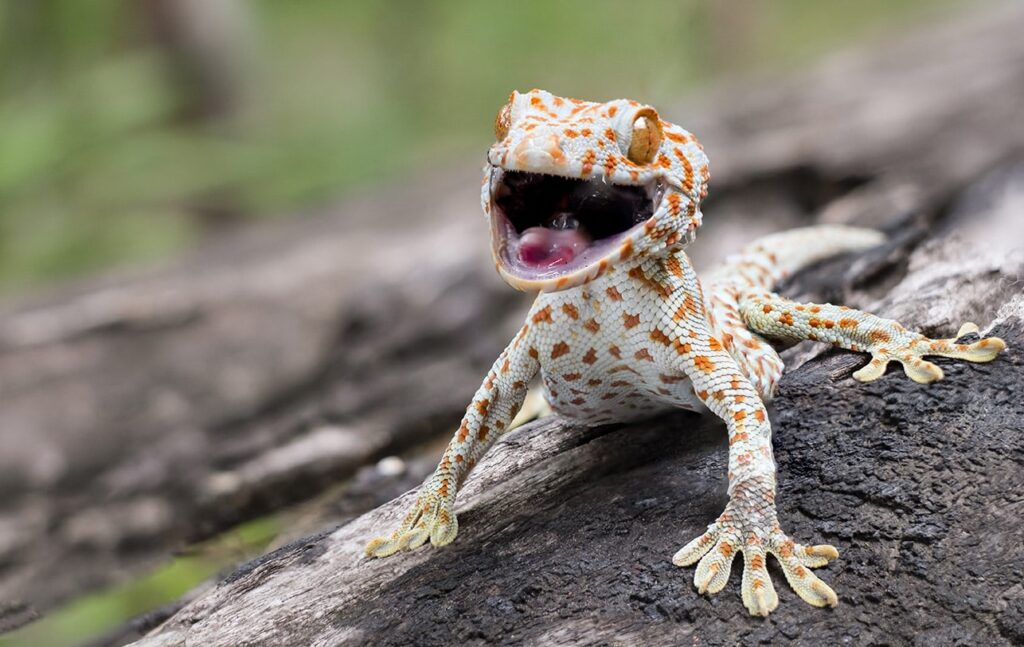
Humidity
Geckos need a humid environment. For a Tokay, 70% humidity is ideal, but anything between 60% and 80% should suffice. Don’t let the humidity in the tank fall below 50%, though. Humidity can be maintained by misting the enclosure with a spray bottle. However, you have to be careful not to overdo it. If the environment is too wet, it could cause health problems for your gecko. Use a hygrometer to ensure that humidity remains at appropriate levels. We prefer the two-in-one thermometer/hygrometer that enables you to keep track of humidity and temperature with one simple device.
Substrate
You want to choose a substrate that will retain moisture and help keep the enclosure humid, but you don’t want it to be wet or soggy or stick to your lizard. Coconut fiber is a great choice, as is orchid bark.
Light
Your Tokay Gecko will need two lights. One can be a natural fluorescent that just provides light during the day. The other needs to be a basking lamp that generates heat. Each will require a dome. You can put them on timers to automate things and make caring for your pet a bit simpler.
- See also: Best Humidity Makers for Geckos
Accessories
Tokay Geckos love to have loads of hiding spots. They prefer to have a cluttered living area that’s covered in logs, rocks, and live plants. These lizards also spend a lot of time climbing, so branches and other items they can climb up and perch on will be appreciated.

Can Tokay Geckos Be Housed Together?
For the most part, Tokay Geckos are best left as solitary lizards, so you should only introduce a single male and female when you want them to mate. In the wild, this is how they mostly live, with males displaying territorial aggression and only allowing females in to mate, lay eggs, and then leave. In captivity, if you’re willing to put in careful work and watch the situation unfold, you might be able to house two or three of these geckos together, but there are guidelines to follow.
First, mature males should never be housed together. The stronger male will eventually chase the smaller or weaker male off and may cause serious harm to him in the process. This is true even for males that got along as juveniles. Second, you don’t want to add a second female to an enclosure with a female that has already mated, as they can become quite territorial. However, you can often keep two females together with a male, provided that they were all introduced before mating took place. If you introduce a second female later, the original female may have partnered with the male in the enclosure, and they could team up to expel the new female from their territory, which could damage or kill her.
If you’re set on housing multiple Tokays together, your best bet is a pair: one female and one male. As stated, two females can be housed with a male if you cohabitate them at the same time, before mating has taken place. Otherwise, it’s safest just to keep each gecko in their own enclosure.

What to Feed Your Tokay Gecko
Tokay Geckos are far from picky eaters. In fact, they’ll eat just about anything that moves and is small enough for them to overpower. This means other lizards and a variety of insects in the wild, but as a pet, your gecko will be feeding on mealworms, crickets, waxworms, roaches, silkworms, hornworms, and even baby mice.
Make sure to gut-load your insects before feeding them to your pet. This is when you fill the insects with nutritional food just before serving them, so the gecko can get all the benefits of the nutrients that they’ve eaten. Also, don’t forget to dust them with a multivitamin to keep your lizard strong and healthy.

Keeping Your Tokay Gecko Healthy
Tokay Geckos are strong, resilient creatures. Even though they’re not recommended for beginners, that’s mainly because of their aggressive temperament, not because they’re difficult to keep healthy. As long as you keep their enclosure at the right temperature with sufficient humidity and they have plenty of space, food, and water, they should live a healthy and long life with minimal input on your part.
Breeding
Tokay Geckos are extremely easy to breed, and they don’t usually require any encouragement, provided that they’re both in good health. For geckos in the wild, the breeding season spans several months, starting in the springtime when it starts to become more humid and daylight hours increase. You can replicate this by simply increasing the humidity in the enclosure and adding an extra hour or two of light each day. Increase feeding slightly so the female has plenty of energy for laying eggs.
You’ll know the male is attracting the female when you hear their loud vocal mating calls. If your male and female are paired together, simply increasing the light and humidity should induce mating. For lizards kept separate, you’ll need to carefully introduce the female to the male’s habitat, watching for any signs of aggression to ensure that your female doesn’t get injured.

Final Thoughts
If you’re new to exotic reptiles, it’s not recommended to start with Tokay Geckos. While they are beautiful creatures, they’re not particularly friendly. Handling them takes a lot of patience and experience, which you should gain on a friendlier, easier-going species like a Leopard Gecko.
For the experienced reptile keeper looking for a challenge and a lizard that’s unique with a bit of a wow factor, a Tokay Gecko might be a good choice. You should be comfortable with lizard bites if you’re going to get one, though, as these are common due to the gecko’s aggressive and territorial nature. But with lots of patience and understanding, you can tame a Tokay and get them comfortable with handling, which to many herpetological enthusiasts, is a major prize and accomplishment all on its own.
Related Reads:
Featured Image Credit: Thichaa, Shutterstock
